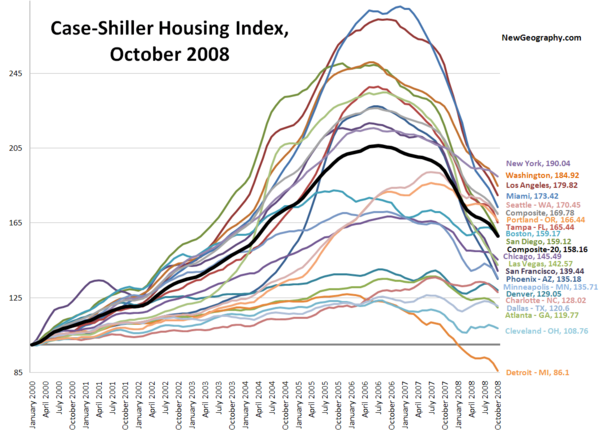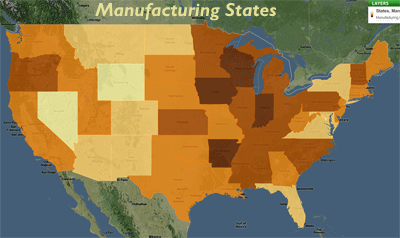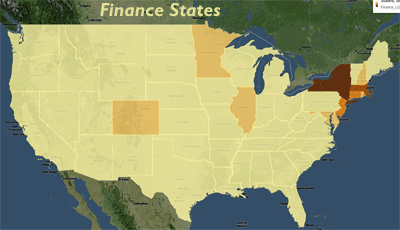NewGeography.com blogs
Today's latest release of the Standard and Poor's Case-Shiller Housing Price Index indicates a continued price free fall across the board. Hyper-inflated markets such as Miami, Los Angeles, Washington, DC, San Diego, and Las Vegas continue to come back to earth. Check out the chart.

Even Charlotte, Denver, Dallas, and Atlanta, which seemed to be holding their own after never seeing a huge price escalation, seem to be sliding again since July. Cleveland seems to have stabilized, but Detroit continues its drop into a black hole. Home prices in Detroit have fallen to almost 14% below levels in early 2000.
Follow this link for a bigger version of the chart.
A new report from the Center on Budget and Policy Priorities highlights the increasingly precarious fiscal situation faced by state governments confronting the ongoing economic downturn. According to CBPP, "at least 44 states faced or are facing shortfalls in their budgets for this and/or next year, and severe fiscal problems are highly likely to continue into the following year as well."
The scope of these emerging deficits varies greatly. Mississippi currently has a budget deficit of around $33 million, which "could reach as high as $70 million-$80 million by the end of the fiscal year." On the high end of the spectrum, California faces the daunting prospect of a $15 Billion deficit for the fiscal year ending June 30, with the potential for "another $25-billion-plus for the next fiscal year," if nothing is done to bring the shortfall under control.
The process of bringing budgets into balance should be the source of much political turmoil over the next year. In Minnesota, which has a predicted two-year deficit of $6 Billion, legislators are beginning to spar over the potential tax increases and budget cuts. On Dec. 26, Gov. Tim Pawlenty announced $271 million in "emergency cuts," with a large share coming from aid payments to local governments. Legally required to have a balanced budget, as are many states, legislative leaders in Minnesota face the prospect of a challenge "so ugly that a special summer session will be needed to finish the budget." In New York, which faces the "largest deficit in state history," Governor David Patterson recently presented an "austerity budget," calling for cuts in state aid to local governments, education funding, and property tax rebate programs. Looking at all potential options to fill the gap, Patterson has also "appointed a commission to look into leasing state assets," including bridges, roads, and parks. The privatization of state assets and infrastructure as a means to raise funds is also being considered in Minnesota and Massachusetts, which faces a FY2009 deficit of over $2 billion.
With states potentially facing a combined deficit of $350 billion through FY2011, the pressure to make difficult policy decisions is sure to increase, as are requests for outside aid. Already, there are calls for the federal government to step into the fray, with governments across the nation "lining up to ask President-elect Barack Obama and the new Congress for hundreds of billions of dollars to plug holes in their budgets". Gov. Ted Strickland of Ohio, facing a two-year deficit of $7.3 billion, is "preparing a pitch for three chunks of money," to be delivered to the states to support education, infrastructure, and aid to the poor. CBPP also argues that there is a need for federal assistance, in order to "lessen the extent to which states take pro-cyclical actions that can further harm the economy." Facing an increasingly challenging economic situation which may limit the options at their disposal, it appears that states will look to the incoming Obama administration to find ways to stop "the bleeding."
With the nation locked in the firm grips of recession, one indicator of our country’s import demand and manufacturing capacity is being stockpiled in Montana. Just south of Great Falls, along the Missouri River, Burlington Northern Santa Fe (BNSF) Railway Co. is stockpiling flatbed container cars – a lot of flatbed cars. By some accounts, there are about 1,500 railcars, or 1.5 percent of the North American flatbed fleet and roughly 5 percent of the BNSF fleet, parked between Great Falls and Helena suggesting that Americans are buying and importing less from foreign manufacturers and manufacturing less for foreign consumption. If and when they are brought back into rotation will depend on freight demand – driven by American consumption.
Infrastructure investment has been a key driver of economic development throughout American history. In our country’s earliest days, the building of canals and turnpikes, followed by construction of railroads, greatly catalyzed expansion and development. Later, investment in electricity and telephone networks facilitated the development of vast expanses of the American landscape. More recently, the national interstate highway system and now the continuing build-out of broadband telecommunications networks have democratized the geography of business endeavors that were once confined to large metropolitan centers.
Highways, airports, harbors, utility distribution systems, railways, water and sewer systems, and communications networks remain critical elements in economic development. But in today’s globally competitive, net-centric economy a great advantage will accrue to regions and industries that develop sophisticated "infrasystems” including such innovation infrastructure such as university and lab facilities, technology and training centers, export processing facilities, and research parks.
These infrasystems – integrating facilities, technology and advanced socio-technical capabilities – have emerged as key drivers of innovation and the locus of future higher-value industries and higher-paying jobs.
Infrasystems differ by region. For some communities they can be constructed around a key asset such as a local hospital, equipped with medical technology and operated by a highly skilled staff of health care professionals. For a place like Wenatchee, Washington where Internet giant Yahoo decided to locate a data center, the key infrasystems asset lay in a highly aggressive economic development community and low cost, clean energy.
Wenatchee represents a classic success story for an infrasystems approach. They took many of the right steps including a $12 million investment by the Port of Chelan County and others in the Confluence Technology Center, a state‐of‐the art facility built specifically to attract information technology companies to the area. Another factor in this success is $50 million investment by the Chelan County Public Utility District (PUD) in laying fiber‐optic cable to homes and businesses.
If our infrastructure policy and financing debate is going to center around miles of paved road, number of bridges or even the number of construction jobs – certainly all worthy objectives – we could still miss the key target of creating long-term employment and making our country, and regions, more competitive. Advanced infrasystems represent the cutting edge economic tool of the 21st Century.
This probably won't shock you, but MapLight is reporting today that those House of Representatives members voting for the auto bailout received 65% more in campaign contributions from the auto industry than did those who voted against:
House Democrats voted overwhelmingly in favor of this bill, 205 voting Yes and 20 voting No (11 not voting). Democrats voting Yes received an average of $74,846 each, about 19% more than those voting No, who received an average of $63,140.
House Republicans were somewhat more divided on this bill, 32 voting Yes and 150 voting No (16 not voting). Republicans voting Yes received an average of $69,323 each, 63% more than those voting No, who received an average of $42,598.
MapLight charted a similar situation with the financial industry bailout.
On Monday, Creighton University's Economic Forecasting Group released the latest installment of the Mid-America Economic Survey. The survey of supply managers in nine plains states has been conducted monthly since 1994 to "produce leading economic indicators of the Mid-America economy." The survey provides a snapshot of economic activity in the states of Arkansas, Iowa, Kansas, Minnesota, Missouri, Nebraska, North Dakota, Oklahoma and South Dakota.
For November, the economic picture was less than positive. The survey's primary index hit a second straight all-time low in November, recording a score of 37.8. Any score below 50 "indicates a contracting economy over the next six to eight months." Only one state surveyed, North Dakota, showed a growing economy, with an index reading of 55.7, down from both September and October.
Employment prospects in the area were also negative, with the region showing "job losses for the tenth time in the past 11 months." This led to a "very weak" November employment index figure of 39.0, down from 49.7 in October, another record low. Creighton economics professor Ernie Goss, a member of the forecast group, expects "regional job losses to mount in the months ahead with rapidly rising unemployment rates for most states." According to Goss, the area is "now in a recession and I expect it to rival the recession of 1981-82 in terms of joblessness and job losses."
Echoing such findings today, the Federal Reserve released the latest edition of the Summary of Commentary on Current Economic Conditions, more commonly referred to as the Beige Book. According to the report, "overall economic activity weakened across all Federal Reserve Districts," with declines in retail sales, manufacturing activity, and housing prices being reported in nearly all districts. On the plains, the Minneapolis and Kansas City Fed districts both reported weaker overall economic activity.
Hopes for a quick rebound are subdued. According to the Kansas City Fed, their "business contacts expressed little optimism about economic activity going forward." The Mid-America survey reports that economic optimism "captured by the confidence index, slipped to another record low of 22.4" in November. While pockets of strength such as North Dakota remain, communities across the plains now face the prospect of a significant economic downturn.
Last week, Bismarck, ND was host to the second annual Great Plains Energy Expo and Showcase. Hosted by Bismarck State College and Senator Byron Dorgan, the conference focused on North Dakota's growing energy industry, including the wind energy sector, with presenters such as T. Boone Pickens discussing the opportunities and challenges facing the industry.
Wind is a readily available resource on the plains of North Dakota, which have been referred to as the "Saudi Arabia of wind". According to David Hadley of the Midwest ISO, a transmission coordination agency, North Dakota is the top state in the nation for wind energy potential. At 40% capacity, the state would have over 345,000 MW of potential generation capacity.
Current generating capacity is a minuscule fraction of this potential output. However, North Dakota has seen a major increase in investment in wind energy projects over the past several years. In 2005, there was only 80 MW of wind generation in the state. As of June, 2008, that number stands at "716 MW either in service or under construction, plus another 807.5 MW that has either been site permitted or is in some stage of the siting process." According to the Midwest ISO, potential North Dakota projects being discussed or currently under way add up to 7656 MW of potential generation. One major project under discussion would include 2000 MW of generation, costing around 4 billion dollars. The development is, in the words of one elected official interviewed by the Bismarck Tribune, "truly eye-popping."
Standing in the way of exploiting the Great Plains' wind bonanza is a major challenge- transmission capacity. North Dakota currently has a transmission export limit of 1950 MW, which is fully subscribed by current power producers. While several upgrades to the system are in the works, they will fall far short of the massive build up in transmission infrastructure needed to allow for continued rapid expansion of generation capacity. As one presenter at the Great Plains Expo put it, the region is "a victim of [its] own location."
In August the New York Times discussed the challenge posed by transmission limitations, noting that "North Dakota and South Dakota, could in principle generate half the nation’s electricity from turbines. But the way the national grid is configured, half the country would have to move to the Dakotas in order to use the power." If unaddressed, the inadequacy of the electric grid will serve as a check on energy driven economic development on the Great Plains. Rick Sergel, President of the North American Electricity Reliability Corp. (NERC), argues that "Without new transmission development needed to support these resources," it is likely "only a fraction," of currently proposed wind projects will be built. Speaking to Reuters, Sergel called for serious consideration of "comprehensive plans that cross state lines and international borders to build the clean-energy superhighway that will provide everyone equally with access to carbon-free generation".
It appears that expansion and modernization of transmission infrastructure will receive significant attention from the incoming administration. President-elect Obama stated in an interview on MSNBC that "the most important infrastructure projects that we need is a whole new electricity grid," and that he wants such projects "to be able to get wind power from North Dakota to population centers, like Chicago." With the current economic slowdown increasing calls for an economic stimulus package, investment in infrastructure, including grid expansion and modernization, appears set to take a central role in policy discussions in the coming year.
For our War of the Regions piece I went through BLS data and calculated location quotients for a few key diverging industries, namely manufacturing and securities, commodities and investments side of the finance industry. These are the kind of numbers that really benefit from geographic visualization.
A LQ tells us not where the most jobs are in any given industry, but how much of a state's employment is clustered in the given industry.
I've been following FortiusOne for a while but this is the first time I've gotten a chance to play around with their GEOCommons Finder! and Maker!, a new social production platform for agglomerating, sharing and visualizing geographic data. It's a fantastic platform.
 Click on the map images here to explore them on the GEOCommons platform. You can see a lot of dark color in the rust belt, but at this point, the states of Indiana, Wisconsin, Arkansas, Iowa, Alabama, and Mississippi are at or ahead of Michigan and Ohio in state dependence on Manufacturing. Part of this is due to growth in the South and Great Plains, and part is due to manufacturing job losses in the Rust Belt, causing the concentration there to slip. Click on the map images here to explore them on the GEOCommons platform. You can see a lot of dark color in the rust belt, but at this point, the states of Indiana, Wisconsin, Arkansas, Iowa, Alabama, and Mississippi are at or ahead of Michigan and Ohio in state dependence on Manufacturing. Part of this is due to growth in the South and Great Plains, and part is due to manufacturing job losses in the Rust Belt, causing the concentration there to slip.
 Finance here is limited to Securities, Commodity Contracts, and Other Financial Investments and Related Activities (NAICS 523). Not surprisingly, this industry is clustered in the Northeast. You see Illinois, Minnesota, and Colorado shaded darker due to the role of Chicago, Minneapolis, and Denver as regional trade centers. Finance here is limited to Securities, Commodity Contracts, and Other Financial Investments and Related Activities (NAICS 523). Not surprisingly, this industry is clustered in the Northeast. You see Illinois, Minnesota, and Colorado shaded darker due to the role of Chicago, Minneapolis, and Denver as regional trade centers.
Take some time to explore GEOCommons and some of the other visualizations created by others, and watch for more maps in this space as we do the same.
While the decline in housing prices in America has been making news for some time now, less attention has been paid on this side of the Atlantic to the downturn in European housing. The housing market in Europe, much like that of the United States, "soared during the first half of this decade, rising far beyond the levels that you'd expect, based on traditional economic factors."
The fallout from the bubble is beginning to look the same, if not worse. According to Newsweek, over the first six months of 2008, housing prices in several European nations, including the United Kingdom, Spain, Sweden, and Norway, have fallen "at a faster rate than is occurring in the United States." According to one analyst interviewed by Newsweek, the European downturn is still in an "early stage".
Eastern Europe is also seeing major fallout from deflation of the real estate bubble. According to Reuters, nations such as Bulgaria, Romania, and the Baltic republics of Latvia, Estonia, and Lithuania, have seen property prices plummet as easy access to credit has dried up. A Bulgarian property agent interviewed by Reuters reported that "No-one is buying. Everything has frozen". The credit crunch has led to fears of "a wave of bank and currency crises," which might necessitate IMF bailouts of several Eastern European nations. In the past two weeks Hungary and Ukraine have been bailed out, with the IMF providing loans "totaling $32 billion, in exchange for belt-tightening."
A recent report on European housing by Stratfor argues that the housing bubble faced by Europe was larger than that seen in the United States, and in correcting could lead to a "long-term deflationary spiral". The report points out that in addition to facing overheated housing markets, Europe, over the long-term, faces a "poor demographic situation," with a birth rate well below replacement level. According to Stratfor, this situation "will dampen the demand for housing in the long term and possibly create a deflationary spiral in the housing market".
Not all analysts are so gloomy, with some arguing that "the practice of giving mortgages to less credit-worthy buyers," never reached the same levels in Europe, and that while prices did boom, there is not a "vast glut of never-lived-in houses sitting vacant on the market," which should help to mitigate the situation. Regardless of the severity, it appears clear that Europe is set to face a continued period of real estate value contraction.
|















